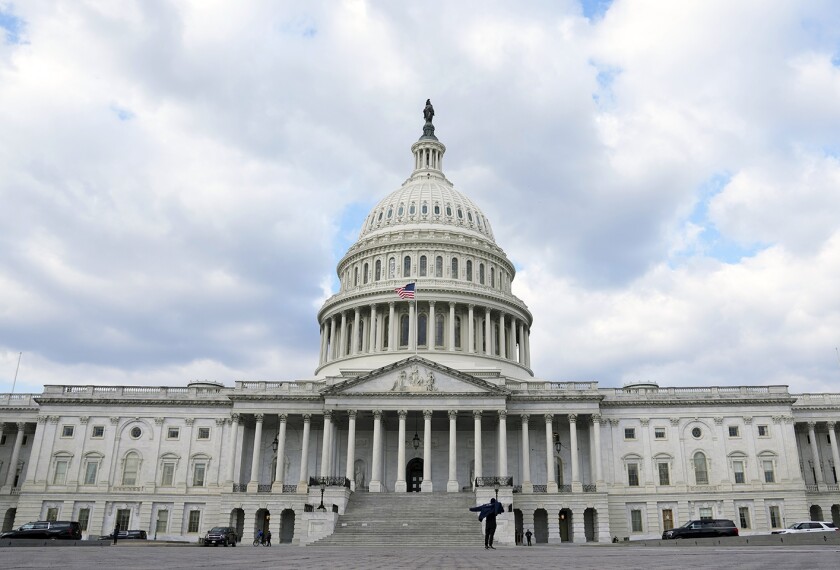State education leaders came to Capitol Hill for two days to hunt for ways their rural schools can meet the toughest requirements of the “No Child Left Behind” Act of 2001. They left town with some of the solutions they were seeking.
The Council of Chief State School Officers gathered leaders from 11 states here May 29 and 30 to talk through the biggest problems those schools face as they try to follow the law’s requirements on teacher quality, test-score improvement, and extra help for needy students.
In recent months, state leaders in Maine, Montana, Alaska, and elsewhere have worried publicly about how the federal government might crack down on rural schools, and they have been clamoring for help from Congress and the Department of Education. (“Montana Leads Choir of Rural Concerns Over ‘No Child’ Law,” April 2, 2003.)
Signs were clear last week that Washington is starting to listen.
State leaders said they were encouraged by the meetings at the CCSSO, where they heard federal officials talk more about cooperation than regulation. The group met with congressional aides, with Susan A. Sclafani, who is a counselor and senior aide to Secretary of Education Rod Paige, and with Scott Jenkins, the agency’s deputy assistant secretary for intergovernmental affairs.
“The department definitely sounded willing to give us some flexibility in rural situations,” said Patricia Sullivan, a deputy executive director of the CCSSO, a national group based here that represents state commissioners and superintendents of education.
A Numbers Problem
The most encouraging news for rural states was about test scores. The adequate yearly progress, or AYP, required for schools and various subgroups of students on standardized tests will be hard for many schools to attain. But rural and small schools face a particular statistical challenge: having large enough samples of students to measure such progress accurately.
“Twenty-five percent of Wyoming’s 4th graders are in schools with less than 10 students” in their grade levels, Judy Catchpole, who recently left office as Wyoming’s elected state education superintendent, said during the meeting.
Linda McCulloch, the state superintendent of public instruction in Montana, said: “We’re not looking for a way out of No Child Left Behind. We’re looking for a way to make No Child Left Behind work in rural states.”
Rural states are finding that they can use various methods, beyond standardized statewide tests, to show adequate progress.
Mr. Jenkins of the Education Department suggested that local-level tests or other measures might also be used to measure progress. “For verification purposes [some states are using] other indicators,” he said.
That was good news for Maine’s superintendent, Susan Gendron, who wants her state to keep its locally approved tests.
The federal Education Department has also approved some state accountability plans under the law that would average test results across all grades in a school or use other statistical techniques to increase the reliability of decisions, particularly for small schools. (“Small Schools Pose Big Challenges,” Feb. 19, 2003.)
State officials in general weren’t sure, however, if the flexibility under the law would help more of their schools avoid a designation of needing improvement, which under the law occurs if a school fails to make adequate progress for two years in a row.
Finding Teachers
The biggest problem for many rural schools remains finding teachers who are qualified under the federal law, and then keeping them. But a few ideas have come to light.
Federal officials told rural leaders here that states and school districts could fare well under the No Child Left Behind law if they work to expand their teacher-recruitment efforts—and make their goals and shortcomings on teacher quality clear to parents. Letters home or other notification could be the proper way to lay out plans for improving teacher quality, the federal officials told the group, Ms. Sullivan said.
Every public school in the nation must have a “highly qualified” teacher in every class in core subjects by the end of the 2005-06 school year under the No Child Left Behind Act, the reauthorization of the Elementary and Secondary Education Act. “Highly qualified” means that a teacher has been certified or licensed by a state and has demonstrated a high level of competence in the subject being taught.
Other issues were on rural leaders’ minds. They wondered, for instance, how states with relatively small education agencies and districts will have the personnel and organizational muscle to help low-performing schools.
North Carolina currently has 78 teachers assigned to intervene in the state’s lowest-rated schools. But if the federal law forces the state to expand its list of failing schools into the hundreds, that situation might require a different type of intervention strategy, said William McGrady, a section chief for the North Carolina Department of Public Instruction.
School choice and supplemental services also came up during the meeting. While the federal law requires schools to allow students to transfer from failing schools, rural students often have no nearby alternatives.
Schools in certain circumstances must offer tutoring or other services to supplement a student’s education. But that’s a problem in districts where there are few agencies in communities beyond the schools, and no private companies lining up to offer the programs.
“We haven’t solved that problem yet,” said Vicki Dahn, the curriculum director for the Utah State Office of Education.




